The Bronx is Modern: Below East 161st Street
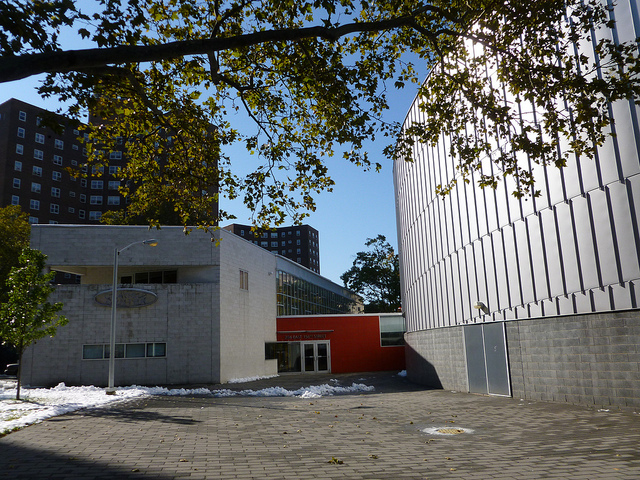 Entrance to the Melrose Community Center [Deena Parham]
Entrance to the Melrose Community Center [Deena Parham]
This year, I've decided to include a few posts dedicated to architectural treasures in the Bronx. Today's installment is about Bronx modernism.
Recently, I mentioned to friends that I went on a tour of modern Bronx buildings. I received several quizzical looks, followed by a collective, “Really?”
As quiet as it is kept, several giants of the modern architectural movement such as Paul Rudolph, and Marcel Breuer had early commissions in the Bronx. As I’ve mentioned in previous posts, the Bronx is still stuck in the “buildings are burning” narrative, so this fact is not widely disseminated. This post will venture into territory where most tours fear to tread- celebrating the borough’s modern architectural heritage!
The Melrose Community Center, 286 East 156th Street, Bronx, NY
[Formal name of building: South Bronx Classic Community Center at Melrose Houses]
A mere five minutes from Manhattan are the Melrose, Morrisania, and Jackson public houses in the South Bronx. It’s a typical Post World War II, superblock, Robert Moses-era assemblage of functional architecture that met basic housing needs, but was miserably low on inspiration. The formidable brick buildings with small patches of green space were meant to resemble towers of park. Unfortunately, the sheer density of the high-rise apartment buildings makes the community feel closed, like an impenetrable fortress.
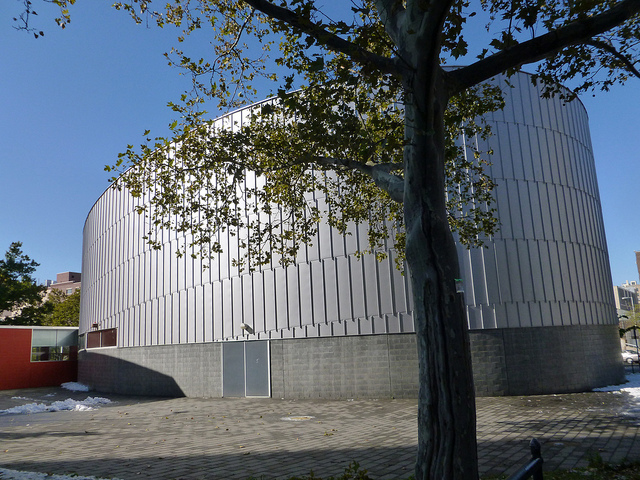 The gym at the Melrose Community Center [Deena Parham]
The gym at the Melrose Community Center [Deena Parham]
After walking past several mature trees, I was pleasantly surprised to see the Melrose Community Center. The 20,000 square foot building was designed by Agrest and Gandelsonas Architects and Wank Adams Slavin (1998-2001) for the New York City Housing Authority. It’s currently used as a cultural, recreational, and educational center for local teens.
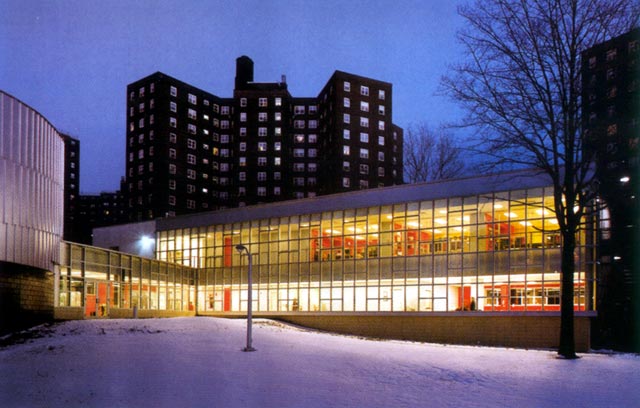 The Melrose Community Center [Agrest and Gandelsonas Architects]
The Melrose Community Center [Agrest and Gandelsonas Architects]
Agrest and Gandelsonas Architects made the following design statement:
The design of the Bronx South Classic Center reflects a desire to avoid a fortress-like environment and instead provide the community with a building that conveys a sense of openness and accessibility. The symbolic aspect of the project is of major importance in its social function for the local residents who live amongst one of New York City's highest crime rates; it has generated a point of identification and pride for the community. The Melrose Community Center is composed of two main volumes enclosing programs, the bar and the oval gymnasium connected by a link which provides the entry space. The gymnasium, with its strongly recognizable form, is a symbolic element of identification for the entire community.
We chose to make the classrooms building as transparent as possible. Curtain wall glazing along the length of the bar exposes the interior to public view in both directions. The various activity rooms have a glass wall oriented towards the circulation corridor, enabling its users to see the activities of everyone else. This visual exchange creates a great sense of energy and excitement.
The Bronx Criminal Court Building 215 East 161st Street, Bronx, Harrison and Abramowitz
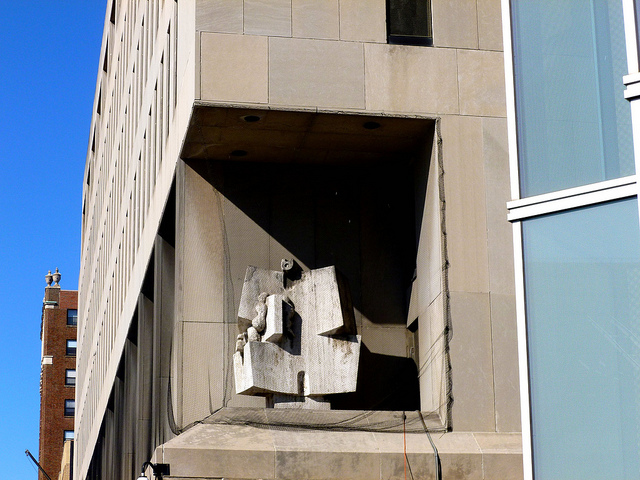 A travertine sculpture by Constantino Nivola at the Bronx Criminal Court Building. [Deena Parham]
A travertine sculpture by Constantino Nivola at the Bronx Criminal Court Building. [Deena Parham]
This $31 million imposing courthouse was designed by the architectural firm of Harrison and Abramowitz (1973-1977). It currently houses the Family Court, Criminal Court and their associated offices, the District Attorney, and offices of the Departments of Probation, Human Resources, Corrections, and NYPD. The bulky limestone clad building is 13-stories tall, and is 600,000 square feet. This building's unwelcoming public presence resulted in a radical design approach when the Bronx Hall of Justice was proposed.
The Bronx County Hall of Justice 215 East 161St Street, Bronx, NY, Rafael Vinoly Architects
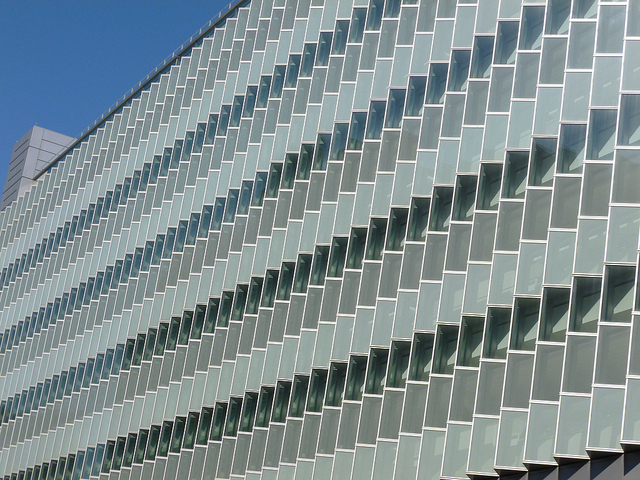 The glass facade of the Bronx County Hall of Justice [Deena Parham]
The glass facade of the Bronx County Hall of Justice [Deena Parham]
Architect Rafael Vinoly’s courthouse project opened to the public in 2008. It is two blocks long, and is one of the largest courthouses in the country. The East 161St Street facade is known for its accordion-fold curtain wall of windows that reflected the brightness of the sunlight. This building’s facade is a stand-out primarily because its intent was to show the transparency of justice, while maintaining a level of privacy.
The $421 million, nine-story, 775,000 square foot building was constructed between 2001 and 2007. The windows were made of translucent glass that was tested at a blast simulator in New Mexico, to ensure that they were resistant to any potential terrorist attack. Overall there are 47 court rooms for the Supreme and Criminal courts, seven grand jury rooms, as well as offices for the Department of Corrections, the Department of Probation, and the Bronx District Attorney.
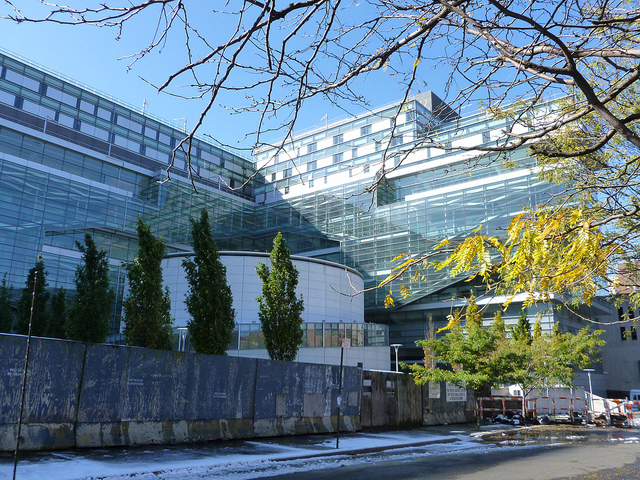 Rear of the Bronx County Hall of Justice where the view of the public plaza is blocked. [Deena Parham]
Rear of the Bronx County Hall of Justice where the view of the public plaza is blocked. [Deena Parham]
While the building was supposed to be a shining example of superior public architecture, the courthouse has had its share of detractors since its opening. Several newspaper accounts have quoted court personnel who have complained that the building is allegedly structurally unsound, has leaking ceilings and sewage pipes, and that overall, it is not very well-maintained.
In the rear of the courthouse building is a public plaza that was meant to soften the institutional building, which faces a residential neighborhood. However, the public space has not been open, due to structural problems with the two-story underground garage. The plaza is currently hidden behind a series of fences that block most of the view. Others wonder if it will ever be open to the public, due to security concerns in the post 9/11 era. Apparently there's also a rooftop Zen garden that was intended for community space, but it is currently not accessible to the public.
 Deena Parham | Comments Off |
Deena Parham | Comments Off |  Melrose,
Melrose,  New York,
New York,  Rafael Vinoly,
Rafael Vinoly,  The Bronx,
The Bronx,  modern architecture in
modern architecture in  Architecture,
Architecture,  New York,
New York,  Urban Planning
Urban Planning